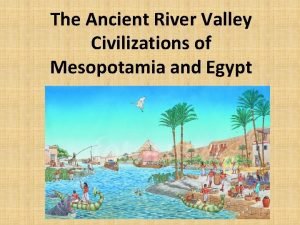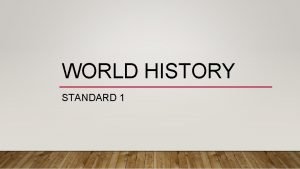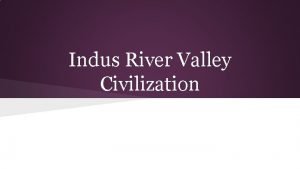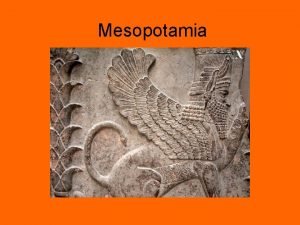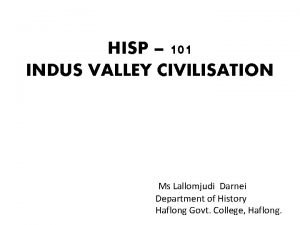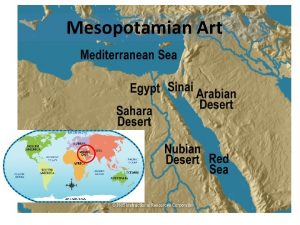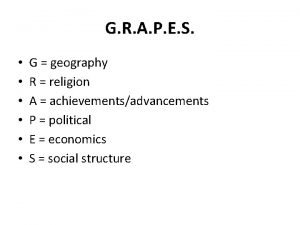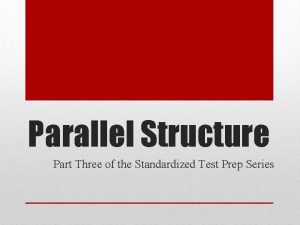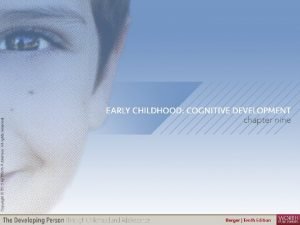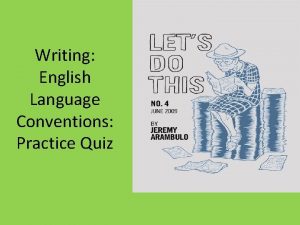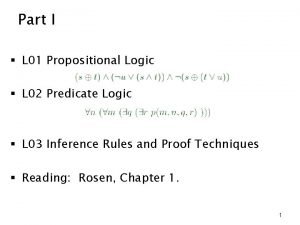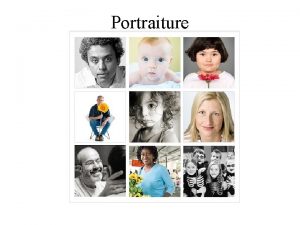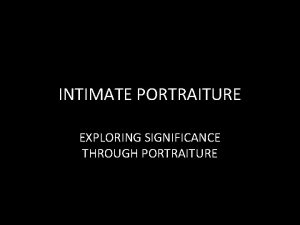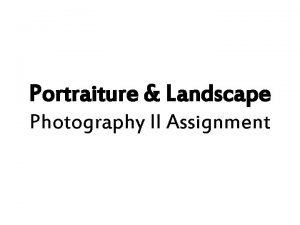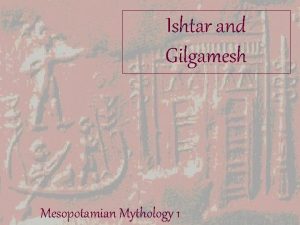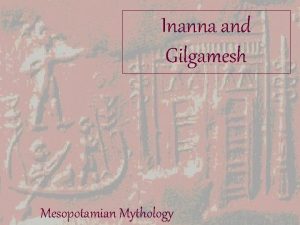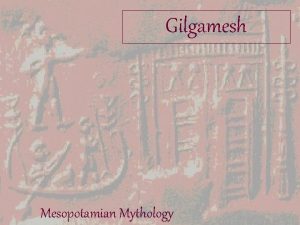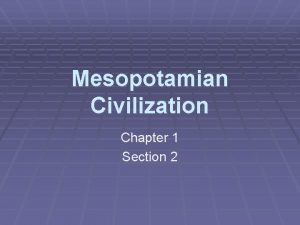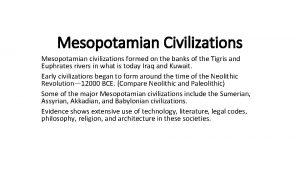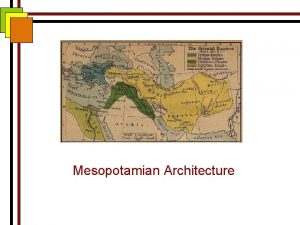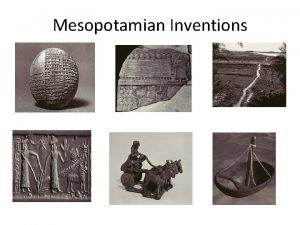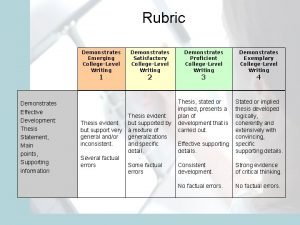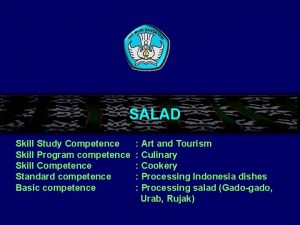Mesopotamian Portraiture in Context Demonstrates skill Skill implies

















- Slides: 17

Mesopotamian Portraiture in Context

*Demonstrates skill/ Skill implies practice And investment. Subject matter Important…. . *Proportion and Symmetry Representational And idealized. *Eyes are Exaggerated Figure 2 -3 Female head (Inanna? ), from Uruk (modern Warka), Iraq, ca. 3200– 3000 BCE. Marble, approx. 8” high. Iraq Museum, Baghdad. 2

• Last class we observed and Analyzed using…. • Sensory Properties and Formal Properties-what do we know That analysis tells us? Figure 2 -5 Statuettes of two worshipers, from the Square Temple at Eshnunna (modern Tell Asmar), Iraq, ca. 2700 BCE. Gypsum inlaid with shell and black limestone, tallest figure approx. 2’ 6” high. Iraq Museum, Baghdad. 3

• Figure 2 -5 Statuettes of two worshipers, from the Square Temple at Eshnunna (modern Tell Asmar), Iraq, ca. 2700 BCE. Gypsum inlaid with shell and black limestone, tallest figure approx. 2’ 6” high. Iraq Museum, Baghdad. • Figures all standard proportions Despite size variations… • We presume commissioned By those wealthy enough to Have their own image in a Temple…. • Eyes believed to represent eternal Wakefulness and duty…. • Although commissioned by individuals and representative of them-the individuals in this Instance mean to signify all Humans in general as opposed to Showing individual portraits © 2005 Saskia Cultural Documentation, Ltd. 4

Presentation of offerings to Inanna (Warka Vase), from Uruk, Iraq, ca. 3200– 3000 BCE. Alabaster • When you begin a descriptive paragraph as an Art Historian, also identify the WHO, WHAT, WHEN, and WHERE in your Description. This will include Mention of the subject matter. Then- explain the Work in detail (This includes Discussing senso and technical Properties) • FORMAL CONCERNS: Size increases in the upper bands… Hierarchy of scale is present in the forms… Costume changes on higher levels as well… 5

• When you reach the next step Of criticism and you begin your Analysis-you discuss the FORM of The piece. Go into detail about the Issues of form that are internal to The work-discuss balance, symmetry, Emphasis and movement. You will Analyze things like line quality, view Of figures, placement in space, size Comparisons…here you are talking About the formal properties of art. FORMAL CONCERNS…Conceptual representation*Not optical –composite view…continuous perspective…. Figures are rigid but lines descriptive 6

• Figure 2 -4 Presentation of offerings to Inanna (Warka Vase), from Uruk, Iraq, ca. 3200– 3000 BCE. Alabaster, 3’ 1/4” high. Iraq Museum, Baghdad. COMMUNICATIVE CONCERNS • First great work of • narrative relief sculpture. • WHAT is the story here? • Conceptual representation • *Not optical –composite view because they did not want to show fleeting aspect of figures. • *Hierarchy of scale and proportion And costumes are used to Place value on the goddess over the People in the hierarchy of gods and Man…. and to show man’s dominion Over the animal world… 7

• Figure 2 -4 Presentation of offerings to Inanna (Warka Vase), from Uruk, Iraq, ca. 3200– 3000 BCE. Alabaster, 3’ 1/4” high. Iraq Museum, Baghdad. • What does this tell about the people/ Culture that made it? • CONTEXT CONCERNS What do we already KNOW about the Culture? What can we link that we “read” here To what we KNOW? How can we use this piece of art to prove A “truth” about the Sumerians? 8

• So-in review: • STEP 1: Identification and sensory Description –address the subject here. . STEP 2: Analysis of FORM and Examination of use of formal properties That are stylistic decisions. Be specific here STEP 3: When you begin to translate and interpret your analysis into your conclusions to put it all in context, you can refer back to your previous statements to make your connections. Here you are addressing expressive properties and relying on Documentary evidence If you have some…. It is here that you will Go deeper into content 9

• Here-formal narrative device offers a new characteristic: : the head of the ruler actually breaks through the top of the register-a formal device that adds to understanding of the content. Also creates emphasis in a narrative that is constant in its style of depiction-blue stone unites the entire background and overall story…. • Figure 2 -8 b Peace side of the Standard of Ur, from Tomb 779, Royal Cemetery, Ur (modern Tell Muqayyar), Iraq, ca. 2600 BCE. Wood inlaid with shell, lapis lazuli, and red limestone, approx. 8” x 1’ 7”. British Museum, London. • The form helps us Understand the content And how it relates to its Context… • Figure 2 -8 a War side of the Standard of Ur, from Tomb 779, Royal Cemetery, Ur (modern Tell Muqayyar), Iraq, ca. 2600 BCE. Wood inlaid with shell, lapis lazuli, and red limestone, approx. 8” x 1’ 7”. British Museum, London. 10

• What role does other iconography have? – Animals: lower status but shown as part of heirarchy: however, animal forms are used to denote the sacred in godhuman imagery…. – Plants: Denote natural world: usually lower but worthy of offering – Objects: As props for narrative in reliefs – Design elements: Serve to organize the stories/frame the images/direct the eye/tame the natural 11

How can put together Everything we observed and Analyzed here together and Link it to what we know about The Sumerians? Notes quiz: ONE QUESTION: Make ONE good statement That links our detailed observations And formal analysis To something you think • Figure 2 -8 b Peace side of the Standard of Ur, from Tomb 779, Royal Cemetery, Ur (modern Tell Muqayyar), Iraq, ca. 2600 BCE. Is relevant that you read Wood inlaid with shell, lapis lazuli, and red limestone, approx. 8” In the book or took notes on in class. x 1’ 7”. British Museum, London. Use terms like: because or used to How could we put together Everything we observed an Analyzed and everything w Know –and create some oth Questions about these People and who they were? 12

Figure 2 -7 Fragment of the victory stele of Eannatum (Stele of the Vultures), from Girsu (modern Telloh), Syria, ca. 2600– 2500 BCE. Limestone, full stele approx. 5’ 11” high. Louvre, Paris. 13

• Marks an event or a grave or both (stele) • How is this piece showing power and authority? • Content (subject matter)? • Symbolism? • Hierarchy of Scale? • Signs of Divinity? • How does this work reflect the style characteristics you have observed in other examples of Sumerian artwork? Figure 2 -7 Alternate View Reverse side: fragment showing king letting vulture eat the enemy © 2005 Saskia Cultural Documentation, Ltd. 14

More characteristics of Sumerian Sculpture: • Bull-head often denotes virility And power…(Symbolism) Animals played a part in the heirarchy of Sumerian Mythology (Subject Matter/ Symbolism) This work of art is arguably of monumental scale Compared to human size. (Monumentality) Figure 2 -9 Bull-headed lyre (restored) from Tomb 789 (“King’s Grave”), Royal Cemetery, Ur (modern Tell Muqayyar), Iraq, ca. 2600 BCE. Gold leaf and lapis lazuli over a wooden core, approx. 5’ 5” high. University Museum, University of Pennsylvania, Philadelphia. 15

• Another Style characteristic: Heraldic Composition (Put it in your notes!) Figure 2 -10 Soundbox of the lyre from Tomb 789 ("King's Grave"), Royal Cemetery, Ur (modern Tell Muqayyar), Iraq, ca. 2600 BCE. Wood with inlaid gold, lapis lazuli, and shell, approx. 1’ 7” high. University Museum, University of Pennsylvania, Philadelphia. 16

Guidelines to making someone look really good on an ancient facebook site… • TOP TEN Characteristics of portraits that communicate a powerful identity as part of a narrative or as a singular image…this is form that reveals content and links to context • • • Hierarchical Scale: The powerful person is larger than others or in center. Monumental Scale: The image is very large. Idealizing the Face: Showing him/her young, blemish free, attractive and/or old and dignified—whatever is valued as perfect in that society… Distorting or Idealizing the Body: Giving the person a strong muscular body, or as is the case in Byzantine art, no body at all. The Pose: Having a person standing or sitting upon a horse makes them look more powerful. Gestures can have a symbolic significance. Placing the person in a setting that evokes Power: a throne room, or performing a miraculous act. The Costume: In some societies certain clothing is reserved for those who have power –sometimes it is a color-other times there are symbols of power ON the clothing…. Relationship to other styles/things/people/environment-the image is shown in comparison to something else or in reference to or association with someone or something else (CONTENT) Subject matter/narrative activities demonstrate a skill or superiority(CONTENT) 17
 Mesopotamian society
Mesopotamian society Conclusion of mesopotamian civilization
Conclusion of mesopotamian civilization Conclusion for mesopotamian civilization
Conclusion for mesopotamian civilization Introduction of indus valley civilization
Introduction of indus valley civilization Introduction to mesopotamian civilization
Introduction to mesopotamian civilization Indus valley civilization conclusion
Indus valley civilization conclusion Mesopotamian art characteristics
Mesopotamian art characteristics Conclusion of mesopotamian civilization
Conclusion of mesopotamian civilization Hard skills vs soft skills
Hard skills vs soft skills High context vs low context culture ppt
High context vs low context culture ppt Spatial deixis
Spatial deixis Contoh komunikasi high context dan low context
Contoh komunikasi high context dan low context Nonagist
Nonagist Choose the sentence that demonstrates parallel structure
Choose the sentence that demonstrates parallel structure Overregularization demonstrates a child's understanding of
Overregularization demonstrates a child's understanding of Latent learning demonstrates that
Latent learning demonstrates that Which sentence demonstrates correct use of the semicolon?
Which sentence demonstrates correct use of the semicolon? P double implies q
P double implies q
